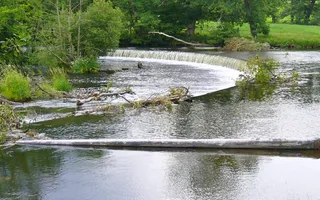Llangollen is most famous for being the festival capital of Wales, and the world turns up on its doorstep every year for the International Musical Eisteddfod. Four main highways also meet here – the River Dee, the Heritage railway, the A5 and the Llangollen Canal – and Llangollen Wharf is the best place to begin exploring the town's glamorous waterways heritage. 11 miles of the Llangollen Canal including Llangollen Wharf and Horseshoe Falls are designated a UNESCO World Heritage Site and this walk gives you a glorious insight into why it is deserves this accolade.
Walk from Llangollen Wharf to Horseshoe Falls
Enjoy a two-mile walk along the beautiful Llangollen Canal.

Canal: Llangollen Canal
Start: Llangollen Wharf OS Grid ref: SJ214423 Postcode: LL20 8TA
Finish: Horseshoe Falls OS Grid ref: SJ195433 Postcode: LL20 8BN
Distance: 3.2km / 2 miles
Route instructions
Start: The Wharf on the hillside overlooks Llangollen, and is busy with boats, people and horses. Canal boats were traditionally pulled along from the towpath by sturdy horses. It has become a rare sight on today's waterways, but the Wharf runs horse-drawn boat trips meandering to the canal's navigable end, so you may find yourself following a gentle giant along the towpath.
1. Follow the towpath past Llangollen Basin, in a beautiful setting popular with visiting boats. The huge white arc of Llangollen Pavilion is visible to your left. The Pavilion, built in 1992, hosts many events including the Llangollen Musical Eisteddfod. Held every July, Llangollen's Eisteddfod is one of the world's greatest music festivals, with musicians and dancers from over 50 countries.
2. Tower Bridge is almost a mini tunnel as the A542 swirls over the canal. This canal unusually has a flow of 2mph as it feeds water to other canals so you may notice a slight current.
3. The ruins of Valle Crucis Abbey, founded in 1201 by Cistercian monks, are just north of Pentrefelin Bridge. Once the second richest abbey in Wales after Tintern, it was dissolved in 1537.
4. From Ty-Craig Bridge, the towpath shares a roadway to the Chainbridge Hotel so be aware of any traffic. The River Dee is below to your left and rocky hillside to your right. A perfect viewpoint overlooks the bridge, river and Berwyn heritage station. The only standard-gauge heritage railway in North Wales, it runs nearly 10 miles from Llangollen through the Dee Valley.
5. The very narrow canal flows through a wooded stretch with the river visible below, before arriving at its head and Horseshoe Falls, set in beautiful scenery. This impressive 140m semi-circular weir across the River Dee is Thomas Telford's dramatic finale for Llangollen's waterway. The weir's crashing water is not just for effect, it keeps a constant supply of water flowing into the canal – an amazing 12 million gallons of water flow daily all the way to Hurleston Reservoir at the other end of the canal.

6. Back at the wharf, head downhill into Llangollen via the Grade I-listed Llangollen Bridge over the River Dee in the valley below the canal. Llangollen Heritage Railway station is on the riverbank.
7. Turn right into narrow Dee Lane, being careful of traffic here. The Corn Mill was founded in the 13th century by Cistercians from Valle Crucis Abbey, and mostly rebuilt in 1786. A working mill until 1974, it is now a stunning riverside pub with a turning water wheel in the bar. Victoria Promenade follows the river's edge. Opened in 1897 to commemorate Queen Victoria's Diamond Jubilee, it leads to Riverside Park, an opportunity for a break before retracing your steps.
8. Follow the path into Parade Street, past Llangollen Museum, and explore the town up Castle Street, passing the Grade II-listed Victorian Town Hall and the restored Y Capel now housing the library, art gallery and tourist information. A detour uphill leads to Plas Newydd, world-famous home of the ‘Ladies of Llangollen'. Irish aristocrats, Lady Eleanor Butler and Miss Sarah Ponsonby, ran away to set up home together here and gradually transformed their simple home into a striking Gothic retreat of carved oak and stained glass. Although scandalising at the time, many in Regency society visited them, including William Wordsworth and Josiah Wedgwood.
9. St Collen's Church, originally founded in the 6th century, has a striking 15th-century carved oak hammer-beam roof. The Ladies of Llangollen are buried here.
End: Follow the road back to Llangollen Bridge. Cross the road, turn left and then follow the footpath sign uphill back to the Wharf.

Last Edited: 18 February 2025


Stay connected
Sign up to our newsletter and discover how we protect canals and help nature thrive


